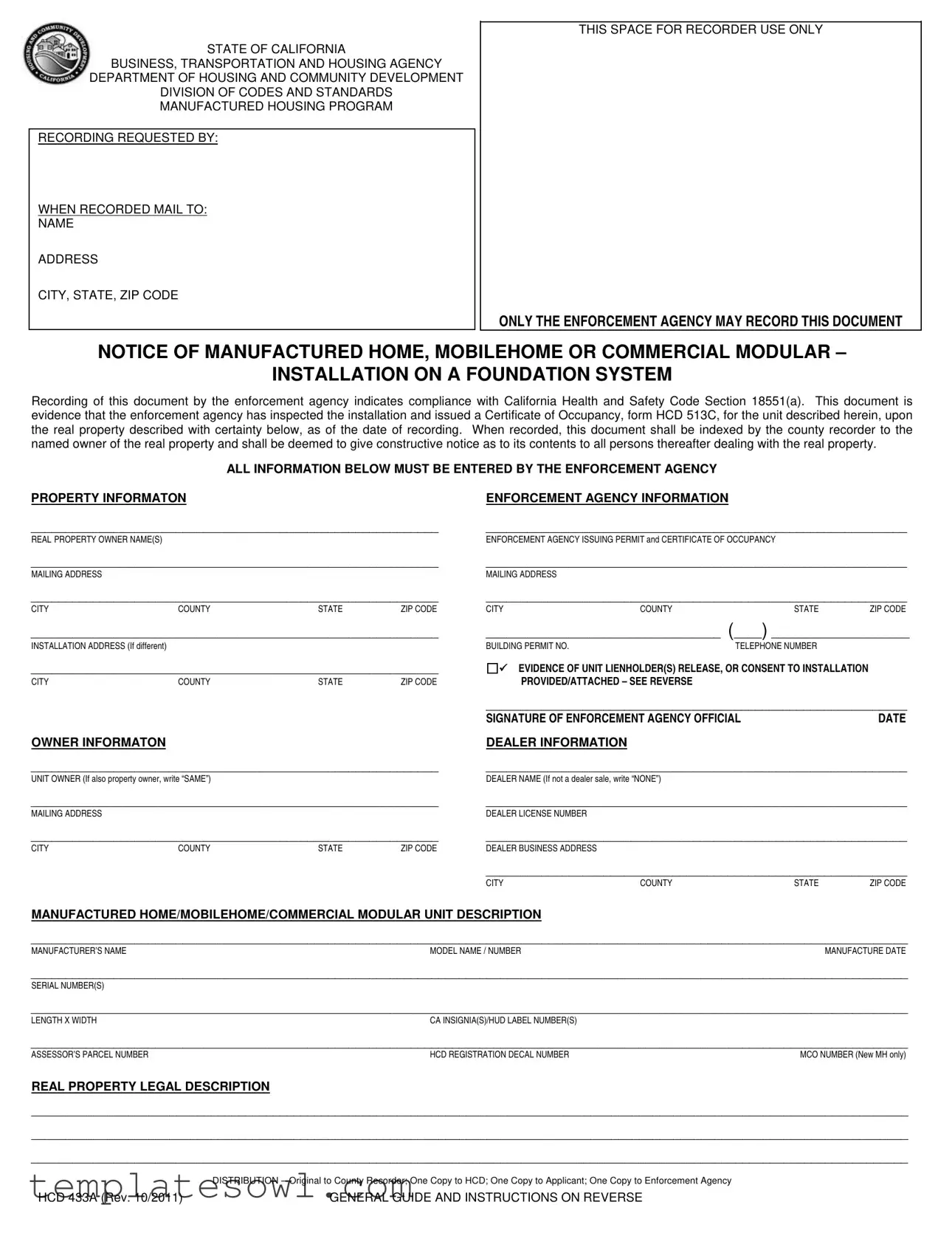NOTICE OF MANUFACTURED HOME, MOBILEHOME OR COMMERCIAL MODULAR
INSTALLATION ON A FOUNDATION SYSTEM
GENERAL GUIDE & INSTRUCTIONS
Prior to installation a building permit to construct a foundation system and install a unit(s) must be obtained from the enforcement agency. To apply for a building permit the owner, dealer or contractor must comply with certain provisions of the California Health and Safety Code Section 18551 as follows:
1)Provide evidence that the registered owner of the unit(s) to be installed either holds title or is purchasing the real property on which the installation is to be made, or holds a transferable lease on the property with a term of 35 years or more. If the term of the lease is less than 35 years, the term must be mutually agreed to by the lessor and lessee and may not be revocable by the lessor, except for cause.
2)Provide written evidence that the registered owner owns the unit(s) free of any liens or if there is a lienholder(s), that lienholder(s) has consented to the placement of the unit(s) on a foundation system as an improvement to the underlying property.
Note: An enforcement agency may obtain a title search from the Department of Housing and Community Development (HCD), Registration and Titling Program. The information on the title search may be compared to the information shown on the surrendered HCD Certificate of Title or Department of Motor Vehicle (DMV) pink slip(s) and registration card(s) (see below). This will ensure that the most recent ownership and registration documents have been submitted to the enforcement agency and that the registered owner owns the unit(s) free of any liens or encumbrances. Where the title search indicates a recorded legal owner or junior lienholder, or both, evidence should be provided to the enforcement agency that the legal owner or junior lienholder, or both, have been paid in full or that the legal owner or junior lienholder, or both, consent to the attachment of the unit(s) upon the satisfaction of their liens by the registered owner.
3)Provide plans and specifications required by HCD regulations.
4)Provide the approved manufacturers installation instructions or plans and specifications signed by a licensed California architect or engineer covering the installation of the unit(s).
5)Pay building permit fees as required by the local jurisdiction issuing the building permit.
6)Complete an original and three copies of the form HCD 433A with all information available at the time the building permit is issued for the installation of a manufactured home or commercial modular unit(s).
7)Pay a state fee of eleven dollars ($11.00) per transportable section and submit with form HCD 433A.
After installation is complete and prior to issuance of a form HCD 513C, Certificate of Occupancy, the following requirements must be met:
1)If the unit(s) has(have) been sold to the owner by a dealer, all information not originally available to complete the form HCD 433A [i.e., manufacturer name, serial number(s), date of manufacture, dealer’s license number and HCD insignia(s)/HUD label number(s)] must be completed. Incomplete forms will be returned for completion.
2)If the unit(s) is(are) owned by the individual requesting installation, the following items are required to be surrendered to the local building department prior to issuance of a Certificate of Occupancy:
oCertificate of Title and Registration issued by either HCD or DMV. o Any license plates or decals issued by either HCD or DMV.
CAUTION: DO NOT REMOVE THE HCD INSIGNIA(S)/HUD LABEL(S) THAT CERTIFY THE COMPLIANCE OF THE UNIT(S).
3)When the form HCD 433A is completed, with all required information and all titles, certificates, plates or decals (if required) surrendered, a Certificate of Occupancy, may be issued and the form HCD 433A recorded with the county recorder. The owner is to be provided with a copy of the form HCD 433B, Notice to Assessor, by the local building department. The owner is required to complete and submit the Notice to Assessor to the county assessor.
4)On the day the Certificate of Occupancy is issued, the enforcement agency shall record this document with the county recorders office.
5)Once recorded, the enforcement agency shall transmit all of the following: the recorded copy of the form HCD 433A; a copy of the Certificate of Occupancy; fees collected in the amount of eleven dollars ($11.00) per transportable section; and, if unit currently titled as personal property, all applicable titles, certificates, license plates or registration decals to:
Department of Housing and Community Development
Division of Codes and Standards
Registration and Titling Program
Post Office Box 2111
Sacramento, CA 95812-2111
For information on establishing a requestor account for obtaining title search printouts on-line, call
(916)323-9229 or submit a request via the internet at http://www.hcd.ca.gov/codes/rt/. For general information or questions, call (916) 445-3338.

